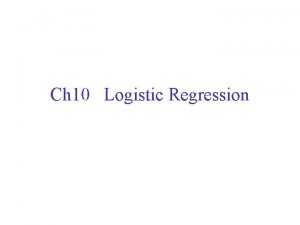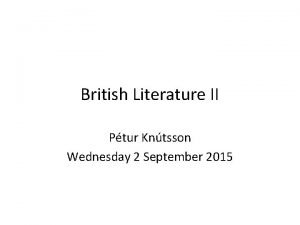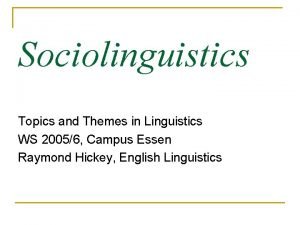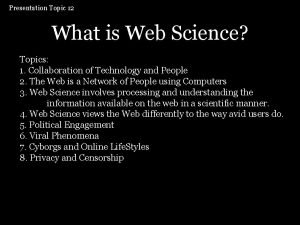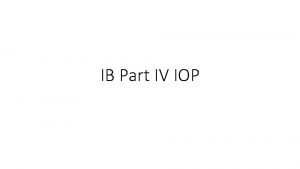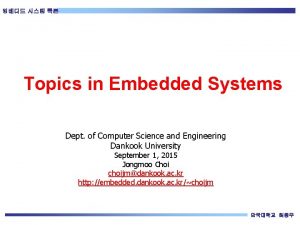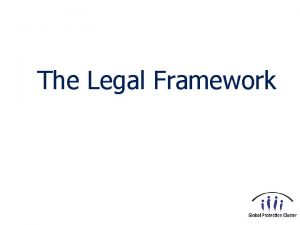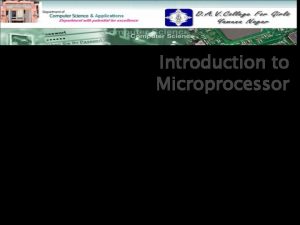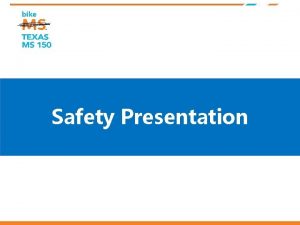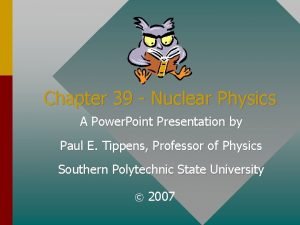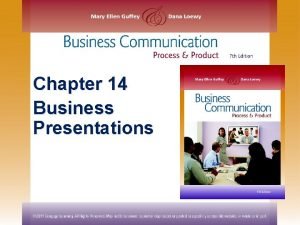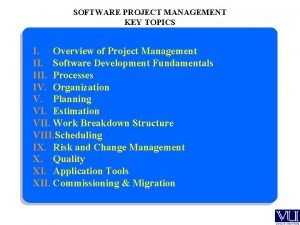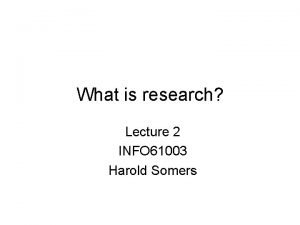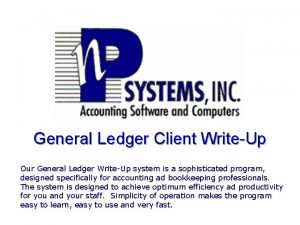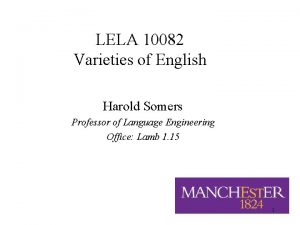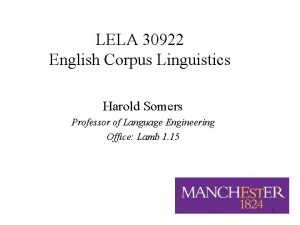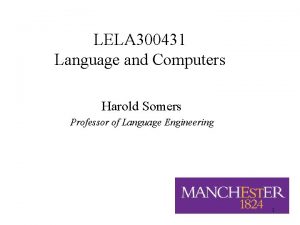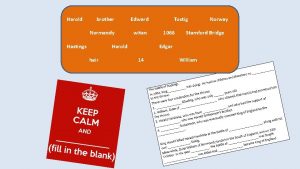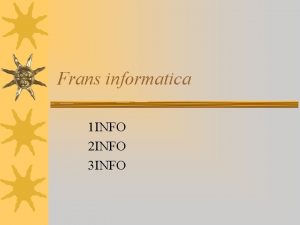Project Writeup INFO 61003 Harold Somers Topics Presentation

















- Slides: 17

Project Write-up INFO 61003 Harold Somers

Topics • Presentation guidelines – Layout – Binding – Contents • Scientific writing • Using MS Word 2

Layout • Double or 1. 5 spacing – Except quotes, footnotes and references: single spaced • Single or double-sided pages • Font size 12 pt – Use a serifed font (eg Times) for the main text – Sans serif (eg Arial) for main titles • • Left margin ≥ 40 mm Other margins ≥ 15 mm Number all pages except title page Text should be justified 3

Requirements • Title page – See Handbook for layout • Table of Contents – Lists of tables, figures etc. are recommended, but not essential, especially if there are only a few • • Abstract (see later) Declaration Copyright statement (see handbook) (Optional) Dedication, acknowledgments, author’s profile 4

Binding • Submit two copies • Dissertations must be bound – Ring binding or spiral binding is not acceptable • Hard binding, sewn is OK, but we recommend. . . • Soft binding – Acetate or plain card cover, card rear cover – Glued spine or channel bound – Gold lettering on spine (see Handbook) 5

(Typical) Contents • Abstract • Introduction • Background – Literature review • Description of implementation/experiment • Experiment or evaluation – Description – Results – Discussion • General discussion • Conclusion – Brief summary (no new points) – What next? 6

Abstract • Abstract ≠ Introduction • It should not be the same text, nor even say the same thing • It should summarize the whole paper, including the results (not promise results) • It should not contain references • It should tell the potential reader everything they need to know to decide whether to read the full paper • It comes first but you should write it last 7

Scientific writing • What to say, how to say it • Should be scientific, not journalistic or political • Don’t state the obvious – “I’m studying this topic because it is interesting” • Give opinions and conclusions – Clearly distinguish yours from those of other sources • Discuss difficulties that are inherent, not personal – No one is interested that it took you longer than expected to learn Java – And it is certainly not an excuse for underachieving 8

Scientific writing • What to say, how to say it • Best way to acquire good scientific writing style is to read and imitate • Do not use “I” – Some people refer to “the author” • I find this awkward, and potentially confusing, cf “the present author” – “We” is unobtrusive, though note possible confusion between inclusive and exclusive “we” • Avoid gender-specific pronouns – Use the weird singular “they”: “If a user has difficulties, they can ask for help” – Better still, use plurals: “If users have difficulties. . . ” 9

Pronouns • Do not use “I” – Some people refer to “the author” • I find this awkward, and potentially confusing, cf “the present author” – “We” is unobtrusive, though note possible confusion between inclusive and exclusive “we”: • “As we will see later” vs. “As we will show later” – Find ways to avoid it altogether: “as will be shown” • Avoid gender-specific pronouns – Some people like “S/he”, “his/her”, but better is. . . – Use the weird singular “they”: “If a user has difficulties, they can ask for help” – Even better, use real plurals: “If users have difficulties. . . ” 10

Numbering, Figures and Tables • Show page numbers • Number chapters and sections, down to about three levels • Number and caption all figures and tables – A useful convention is to have a different numeral style for figures and tables, eg 3 vs III • Always refer to figures and tables in the text, by number (not “as follows”) • When is a figure a table (or vice versa)? • Allow them to float (see later) – Try not to break a table over a page break – Do not have large blank spaces – Keep them together with their caption 11

Abbreviations • Use abbreviations for often-repeated long phrases • Write as if abbreviation is read out as it appears – “World wide web” or “WWW” ? – “an EPRS”, “a URL”, “an HMM”, “an F 2 PR converter” • Acronyms should usually be written in small caps or mixed case: “Di. SPa. R (Direct Service Payment Routine)” • Introduce the abbreviation (even if well established in the field) the first time it appears (other than in the abstract) and then always use it thereafter – “long-term user (LTU)” – “URHC (upper right-hand corner)” • To form a plural, add “s” (no apostrophe): LTUs 12

Proof reading • Use a spell checker – But remember some errors remain (e. g. from/form) • Make sure it is set to British English • Get someone to check your English or. . . • (if native speaker) Read it aloud – If you stumble, it’s badly written 13

A few widespread errors • “However” has two meanings: – It seems bad however you look at it. – It seems bad however I will persevere – It seems bad. However, I will persevere • The followings (sic) have no plural: – software, research, literature, vocabulary 14

Latin • • • e. g. = for example i. e. = that is etc. = and so on et al. = and others ibid. = the same • It is often better to use the English equivalents in running text, like this for example • . . . Especially at the start of a sentence • Do not use e. g. and etc. together 15

Punctuation • Colons and semi-colons are dead useful – A semicolon can link two sentences that you feel are connected; this is an example – A colon is used to introduce an example: thus • Hyphens and dashes are not the same – A dash is bigger “-” vs. “–” • Word can be set to automatically turn a hyphen into a dash; otherwise use ctrl – A dash should have a space either side – Dashes should come in pairs, like parentheses – People often use dashes where a colon would be better – like this 16

Getting the best out of MS Word • Use the style definitions for section headings – Consistency – Looks good • Put each chapter in a different file • Use cross-reference for figures and bibliographic references 17
 Somers d
Somers d Titlingur
Titlingur Lloyd quarterman parents
Lloyd quarterman parents Sociolinguistics topics for presentation
Sociolinguistics topics for presentation Wildlife topics for presentation
Wildlife topics for presentation Science presentation topics
Science presentation topics Individual oral presentation
Individual oral presentation Botany topics for presentation
Botany topics for presentation Embedded systems topics for presentation
Embedded systems topics for presentation Legal topics for presentation
Legal topics for presentation Conclusion of csr
Conclusion of csr Power point presentation topic in hindi
Power point presentation topic in hindi Overview of microprocessor
Overview of microprocessor Safety moment presentation
Safety moment presentation Oop presentation topics
Oop presentation topics Nuclear physics topics for presentation
Nuclear physics topics for presentation Multimedia presentation topics
Multimedia presentation topics Software project management topics
Software project management topics
